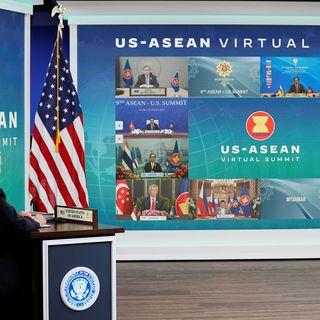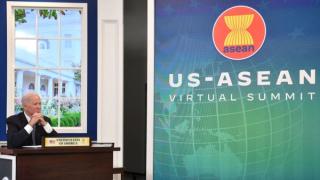In the words of US President Joe Biden's national security adviser Jake Sullivan, in its foreign policy the United States is building a "latticework" of alliances and partnerships - a more flexible and ad hoc approach to international architecture.
This focus on working with friends and allies signals a rejection of former president Donald Trump's unilateralist and confrontational approach, and a will to build flexible coalitions of like-minded countries to support the priorities of the US, especially when it comes to dealing with China.
Yet the Biden administration is not traditionally multilateralist.
Indeed, in Asia, this has seen the administration invest more energy in new groups like the Quad and Aukus.
The Quad is a strategic dialogue between the US, India, Japan and Australia, while Aukus is a trilateral security pact involving Australia, the United Kingdom and the US for the Indo-Pacific region, in which the latter two countries will help Australia to acquire nuclear-powered submarines.
A seat at the table: The role of regional multilateral institutions in US Indo-Pacific strategy

But what about established regional multilateral institutions such as the US partnership with Asean (Association of South-east Asian Nations), EAS (East Asia Summit) and Apec (Asia-Pacific Economic Cooperation)?
A lattice is a structure made from strips of wood or other material that cross over each other with spaces in between. Are Asean, EAS and Apec "the spaces in between" in US strategy?
When it comes to Asean, the Biden administration's performance in 2021 was merely a "pass". It turned up at key meetings, redressing the Trump administration's neglect, but its engagement still lags behind other partners. Australia and China saw their relations with Asean elevated to "comprehensive strategic partnerships"; the US did not.
Washington is now reportedly proposing to host a summit with Asean leaders, but this will come almost two years after Covid-19 forced the cancellation of an earlier planned meeting.
In contrast, the Quad has become a lynchpin of US Indo-Pacific strategy, with President Biden prioritising two leaders' meetings this year, including a virtual summit within two months of taking office.
Though many of Mr Biden's Asia team served in the Obama administration, this early focus on "minilateralism" is distinct from Mr Obama's later investment in traditional Asian multilateralism.
Revealingly, during a speech in Singapore in August, US Vice-President Kamala Harris spoke of "new, results-oriented groups", subtly betraying Washington's impatience with the region's existing architecture.
It is apparent that there is a tension between the Quad and Asean-centric institutions in Mr Biden's Asia strategy - yet Washington's engagement with regional multilateral institutions remains essential.
What's behind the 'lattice'?
The shift is driven by growing tensions between Washington and Beijing.
Growing strategic competition has eroded hopes that inclusive regional forums can help promote dialogue.
Even around 10 years ago, when the EAS was expanded to include the US, many countries hoped that it could bring the region's leaders together and lower the risk of misunderstanding or conflict.
The "latticework" approach makes sense when the US' goal is to encourage like-minded countries to align with its positions on China. Yet if this comes at the expense of the region's established architecture, it will be at a cost to the US' future influence in Asia.
Few today would hold the same aspirations, with some South-east Asian countries even voicing concerns during the Trump years that the EAS was becoming a forum for divisive US-China tensions.
US retrenchment from regional economic arrangements has also undermined some existing regional institutions.
The Biden administration has been unwilling to countenance joining existing regional trade groups like the Comprehensive and Progressive Agreement for Trans-Pacific Partnership. This means its new "Indo-Pacific economic framework" will also likely be built ad hoc with willing partner countries, risking further splintering of the region's architecture.
The "latticework" approach makes sense when the US' goal is to encourage like-minded countries to align with its positions on China.
Yet if this comes at the expense of the region's established architecture, it will be at a cost to the US' future influence in Asia.
Advantages of engagement
Established institutions offer the opportunity to engage with Asian countries on their own terms, avoiding the perception that the US is too focused on a few countries which share its approach to China.
For countries of the Indo-Pacific, in South-east Asia and beyond, inclusive regional multilateral institutions matter. They reflect the idea of an open region in which every country has a voice, and the agenda is not set by a small group of more powerful countries.
This sense is reflected in South-east Asian countries' attachment to the principle of "Asean centrality".
The Biden administration probably correctly judges that Asean-led institutions don't tend to deliver quick wins. But it should not overlook the potential of these institutions to set regional norms and help hold China to account for its regional revisionism.
The Obama administration, for example, used its participation in groups like the EAS to powerfully rebut China's claim that "outside" countries shouldn't have a role on issues like the South China Sea.
US support is also essential in sustaining the relevance of inclusive groups like the EAS. Without its investment of energy and ideas - beyond simply turning up - the EAS risks continued decline, in favour of more exclusive groups such as the Asean Plus Three, which comprises the Asean countries, China, Japan and South Korea.
The exclusive "East Asian regionalism" that this group represents would be to the detriment of all countries in the Indo-Pacific region - both those which are excluded, such as the US, Australia and India, and those which would be disadvantaged by these countries' absence.
The need to work with all
Small ad hoc groups like the Quad are useful for competing with China. They demonstrate alignment among close partners and a shared will to advance a positive alternative to a China-led regional order.
But they are less useful if the goal is to build influence with a more diverse range of regional countries, many of which are wary of Washington's approach to competition with Beijing.
As 2021 draws to a close, few would doubt that the Biden administration can work well with its close "allies and partners". The question is whether it can work well with everyone else.
How successfully Washington engages with Asean, Apec and the region's established multilateral architecture in 2022 will put this to the test.






